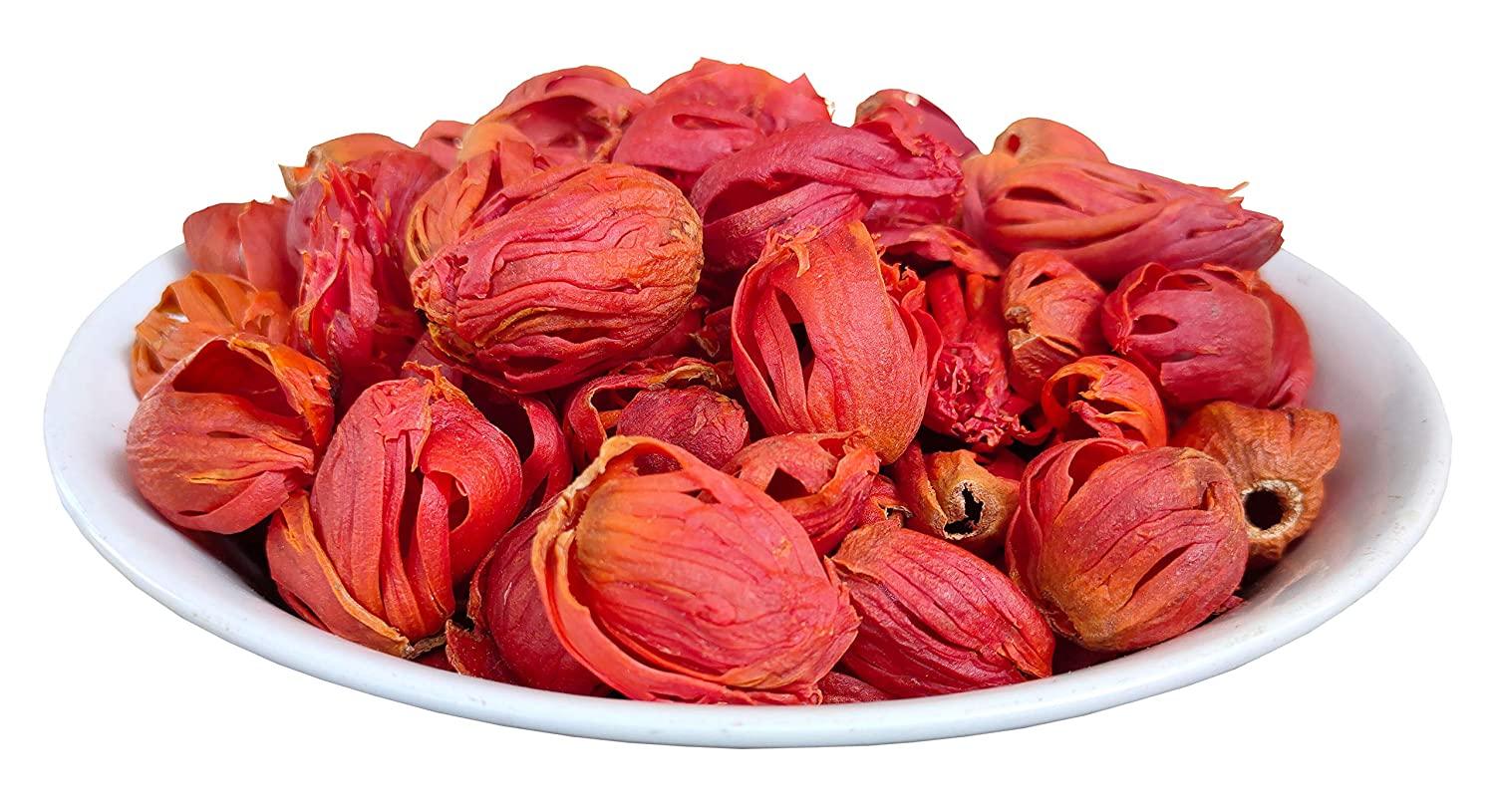All About Mace | Know Your Spice Javitri (Myristica fragrans)
Mace and Nutmeg are two spices both derived from the Myristica fragrans tree. Nutmeg comes from the seed of the tree and mace comes from the seed covering making them sister spices.
The seed covering or aril is called mace. It is actually a thin leathery tissue between the stone and the pulp, of the nutmeg fruit of Myristica fragrans.
Also called an arillus, the aril is an outgrowth from a seed that partly or completely covers the seed. It is bright red to purple when harvested, but after drying changes to amber.
The aril is removed from the stone and its broken parts are known as blades.
The Myristica fragrans tree is indigenous to the Banda Islands of Indonesia, and has also been grown in other Caribbean climates.
What are the other names of Mace?
| Indian Languages | Other Languages | |
| Hindi: Javitri, Javathai Bengali: Jaeetri Gujarati: Jaypatri Malayalam: Jathipathri Marathi: Jaypatri Punjabi: – Sanskrit: Jatipatri Tamil: Jaadipathri Telugu: Japathri |
Latin (Botanical): Myristica fragrans Arabic: Basbasa, Fuljan Chinese: – Dutch: – French: Fleur de muscade, Macis German: Muskatblüte, Macis Italian: Mace Spanish: Macía Swedish: – |
What exactly is Mace?
Mace or Javitri (Myristica fragrans) plant is a member of the Myristicaceae (Nutmeg family). It comes from a fruit of the evergreen tree usually 9-12 mtr high.
In the processing of the seed, the crimson-colored aril is removed from the nutmeg seed that it envelops.
The aril is flattened out and dried for 10 to 14 days. Its color changes to pale yellow, orange, or tan.
Whole dried aril consists of flat pieces—smooth, horn-like, and brittle—about 40 mm (1.6 in) long.
Nutmeg tree is indigenous to Molucca or Maluku Islands. The Banda Islands consist of eleven small volcanic islands, and are part of the larger Maluku Islands group.
These islands were the only source of nutmeg and mace production until the mid-19th century.
But now, the major nutmeg and hence mace growing areas are Indonesia and Granada.
It also grows on a smaller scale in Sri Lanka, India, China, Malaysia, Zanzibar, Mauritius and Solomon Islands.
What is the nutritional value of Mace?
Mace features quite a different nutritional profile than nutmeg. It is less in calories, but has more concentrations of essential oils, vitamin-A, vitamin-C, carotenes, iron, and calcium.
What is the chemical composition of Mace?
It contains fixed oil trimyristin, and many essential volatile oils, which gives a sweet aromatic flavour such as myristicin, elemicin, eugenol and safrole.
These oils occur in higher concentration in mace than in nutmeg. The other less important volatile oils are pinene, camphene, dipentene, cineole, linalool, sabinene, safrole, terpineol.
The oils contain the same aromatic component as that of seed but in slightly different amounts and flavour.
It contains p-dimethylstyrene along with seven esters, eight sesquiterpene hydrocarbons. It also contains two unsaturated aliphatic compounds namely 3- methyl -4-decan-l-ol and its acetate.
Red colour of the mace is identified to lycopene.
What is the history of Mace?
The history of this spice can be traced to the 1st century CE when the Roman author Pliny spoke about this one tree which bears two nuts with two distinct flavours.
Its ticket to fame was in the 1600s when the Dutch waged an all-out war on the island of Banda, just to control nutmeg production in the East Indies.
Later, the Dutch even went to the extent of trading the Island of Manhattan, for control over a nutmeg-producing island owned by the British.
When the Dutch controlled the Moluccas (the Spice Islands), one colonial administrator sent orders that the colonists should plant fewer nutmeg trees and more mace trees.
This perhaps was due to confusion of origin and because the yield of mace is much less than nutmeg, it has a greater value.
What is the difference between Javitri & Jaiphal?
| Mace or Javitri |
Nutmeg or Jaiphal |
| Aril or covering of the seed. | Seed of Nutmeg fruit. |
| Gentler flavour | Robust sweeter flavour |
| Used in light coloured dishes | Imparts a pronounced colour so avoided for lighter coloured dishes |
| Contributes to flavouring light-coloured cakes and pastries |
Contributes to pies, puddings, custards, cookies and spice cakes. |
What are the uses of Mace?
- It is a therapeutic ingredient in various traditional medical practices from across the world.
- It is used in baked goods, vegetables, meat as a spice.
- The oil is used in cosmetics and toiletries.
What does Mace taste like?
The spice is often described as a less intensely concentrated version of nutmeg, though it also has notes of cinnamon and black pepper that make it pungent and spicier.
What are the ayurvedic properties of Mace?
Rasa (Taste): Tikta (Bitter), Katu
Guna (Qualities): Teekshna (Strong), Laghu (Light for digestion)
Veerya (Potency): Ushna (Hot)
Vipaka (Taste conversion after digestion): Katu (Undergoes pungent taste after digestion)
Karma (Actions): Dipana, Grahi, Vrsya, Mukhahakledanasaka, Kaphavatapana, Mukhadaurgandhyanasaka.
What can I use Mace for?
- You can use while brewing milk tea or masala milk, primarily because it has notes of pepper.
- You can use it for making pickles, ketchups, curries and sauces.
- You can use it for making delicious mashed potatoes, broths, soups and rice preparations.
- You can use it for making sweets, puddings, muffins, cakes and different kinds of breads.
- You can use it in your garam masala.
- It can enhance clear and creamed soups and casseroles, chicken pies and sauces.
- You can improve beverages with a little mace, especially chocolate drinks and tropical punches.
- To use mace in your biryani is essential.
How long does Mace last?
You need to buy whole mace or its blades instead of powder. The blades last much longer than the powder. Powdered variety loses its flavour rather quickly because of evaporation of essential oils.
Ground mace and blades usually retain the flavour for up to one year, though they may lose some potency after six to eight months.
How do I store Mace?
Like all dried herbs and spices, store it in an airtight container in a cool dark space. Ground mace, however, should be stored in well-sealed packs and used as quickly as possible.
Is there a substitute for Mace?
The best substitute for mace is an equal amount of nutmeg. The flavour of nutmeg is stronger so it may be best to use a little less nutmeg in some recipes.
The next best substitute for ground mace is ground allspice. It has a similar flavour profile but is considerably stronger. Half the amount of allspice should work well and you can adjust as desired.
Where do I buy Mace from?
In the supermarkets, you can buy whole mace, straight slivers known as mace blades, or ground powder packed inside airtight containers.
If buying online try amazon here.
What are the health benefits of Mace?
The following are health benefits of Mace Spice (Myristica fragrans) or Javitri
- Health Benefits of Javitri as an Antioxidant – Antioxidants are naturally occurring compounds that help protect cells against damage caused by unstable molecules known as free radicals.
- Health Benefits of Mace against Diabetes – Studies have shown that Mace is an excellent choice for people trying to manage their diabetes. It boosts blood circulation that helps prevent diabetes along with other life-threatening problems.
- Health Benefits of Javitri for Heart Health – Mace may be extremely beneficial for your cardiovascular health. It acts as a cardiac tonic and improves the heart metabolism.
- Health Benefits of Mace as an Antibacterial & Antifungal Agent – Due to its antibacterial properties that can kill the bacteria, mace is used in several kinds of toothpaste too.
- Health Benefits of Javitri as an Anti-inflammatory Agent – Mace is filled with vitamins, minerals, and antioxidants that includes essential compounds that are known for anti-inflammatory abilities.
- Health Benefits of Mace as an Antimicrobial Agent – Extracts and oils from the Javitri plant show moderate antimicrobial, antifungal, and antiviral properties.
- Health Benefits of Javitri for Skincare – Javitri can reduce the allergic rhinitis. It is a natural detoxifier which improves the skin tone and complexion.
- Health Benefits of Myristica fragrans for Digestion – Mace keeps the digestive system healthy. It successfully relieves bloating, constipation and gas related problems.
- Health Benefits of Myristica fragrans for Better Sleep – Mace has sleep-inducing properties. If your sleep cycles have been disturbed lately, try adding a pinch of jaiphal to your meals.
- Health Benefits of Mace against Cancer – A survey published in the April 2012 issue of the “Asian Pacific Journal of Tropical Medicine” demonstrated the essential oil of mace might help treat, and perhaps avoid cancer.
- Health Benefits of Myristica fragrans for Bone Health – Mace oil has great abilities of treating muscular and joint pains and sores as it is an excellent sedative.
Mace - Mace Milk | Milk with Javitri Reduces Anxiety and Restlessness
Ingredients
- 0.25 Teaspoon Mace Javitri
- 1 Cup Milk Doodh
Instructions
- Heat up the milk.
- Stir in the mace or javitri powder
- Serve or drink mace or javitri milk hot.
Notes
- Mace - Mace Milk | Milk with Javitri has a natural sweetness so may not require sugar. In case you need to sweeten it more, simply add some honey to it.
Tools & Equipment Used For This Recipe
FInally! To Sum It Up
Mace or Javitri (Myristica fragrans) plant is a member of the Myristicaceae (Nutmeg family). It comes from a fruit of the evergreen tree usually 9-12 mtr high.
In the processing of mace, the crimson-colored aril is removed from the nutmeg seed that it envelops.
The aril is flattened out and dried for 10 to 14 days. Its color changes to pale yellow, orange, or tan.
Whole dry mace consists of flat pieces—smooth, horn-like, and brittle—about 40 mm (1.6 in) long.
Nutmeg tree is indigenous to Molucca or Maluku Islands. The Banda Islands consist of eleven small volcanic islands, and are part of the larger Maluku Islands group.
These islands were the only source of nutmeg and mace production until the mid-19th century.
But now, the major nutmeg and hence mace growing areas are Indonesia and Granada.
It also grows on a smaller scale in Sri Lanka, India, China, Malaysia, Zanzibar, Mauritius and Solomon Islands.
STAY CONNECTED
If you like this article, you can let us know in the comments below or on social media using #gosumitup and tag @gosumitup.
I am always happy to read your feedback and if you liked the dish or if you made the dish. :)
Better still, take a picture and post it on Instagram and tag it as #gosumitup
Connect direct – You can also connect with me directly on my Instagram and Facebook or on Pinterest.
And, keep visiting us for more of such awesomeness. Do bookmark gosumitup.com into your web browser now or simply subscribe to our browser notifications.
This article has been compiled for general information only and should not be used for the diagnosis or treatment of any medical condition/s.
This information is not intended to diagnose, treat, cure, or prevent any disease.
GoSumItUp.com has used all reasonable care in compiling the information but offers no warranty as to its accuracy or its use in any possible form.
Consult a doctor or other health care professional for diagnosis and treatment of any medical condition/s. For more details please refer to our disclosure policy.





